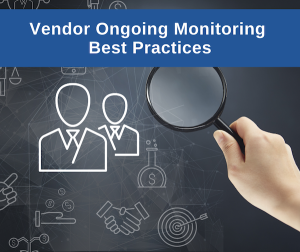Written by the Maple Street Vendor Compliance Team
You’ve finished your due diligence reviews – Now what?

If you’re not doing anything in between reviews, you could be making the decision and contract negotiation process harder and more stressful than it needs to be. At Maple Street, we highly recommend doing some formal monitoring of key vendors during these periods.
Monitoring is as simple as making a note for later reference to use when you’re ready to perform an action, follow up on recurring issues or make a contract decision.
Our team has put together a few guidelines to efficiently and effectively do ongoing monitoring that will lead to better risk management and definitely better outcomes in your vendors’ performance.
1) Key vendor relationship risk areas to monitor
To avoid the frustration of trying to watch too many occurrences, stay focused on select areas or events when monitoring your vendors. For example, you should focus your attention on:
- Ongoing performance issues: member or customer complaints, uptime or access issues, response time and issue resolution
- Financial concerns: unexpected price increases, overbilling or repeated back billing
- Past due diligence review findings: insufficient documentation, SOC audit concerns, financial health, insurance coverage concerns
- Vendor changes or formal notifications: new ownership, mergers, new support services structure, new billing or invoice payment systems
- News about the vendor: data breach, bankruptcy, legal issues
2) When and how to use CADi for ongoing monitoring
Maple Street clients have access to the services of CADi, our vendor management software. It’s very easy to log your monitoring notes directly in CADi. You should decide how often you will log monitoring notes, whether that’s constantly, quarterly, bi-annually, etc. How often you check in and make a note isn’t as important as being consistent. You don’t want to let too much time pass between checking if issues or risks bubbled up. By maintaining a regular cadence, you’ll have written notes to reference later on that tells the story of the institution’s relationship with a vendor and any recurring concerns or unresolved issues. This log of notes will also be available to “show and tell” – a way to prove to examiners and auditors you actually performed ongoing monitoring.
Tips for using CADi to practice ongoing monitoring:
- Vendor Pages – All vendor monitoring can be completed on the vendor’s Vendor Page in the Notes section in CADi.
- Separate notes by type such as “performance” or “financial” so you can organize and reference them later on more easily
- Basic information to include in a note: what happened, why it’s important and who is responsible to follow up, if appropriate
- Date and user stamps: all notes will be date stamped and reference the CADi user who added the note, automatically capturing the when and who
- Collaboration between Business Owners: It’s not effective or efficient that only the assigned business owner tracks vendor events and makes notes. Everyone has different experiences with the same vendors, and everyone who is a Business Owner level user can (and should) make notes in a vendor’s Vendor Page if they experience or encounter the items previously mentioned
- Vendor Watchlist coordination – Here is how the Watchlist can aid in better vendor performance:
- Action items with a time sensitivity or combinations of issues with a single vendor can be monitored via Watchlist through a single, trackable entry.
- Deadlines and assignments will be set for follow up dates to make follow through visible and accountable.
- Make the Vendor Watchlist a part of a standing internal meeting so it’s part of the internal discussion and decision process and easily escalated to the right people when needed.
3) How to use ongoing monitoring actions to get better vendor performance
- Stay focused on the most critical vendors, the repeat offenders and troublemakers, not every single vendor (unless you have the resources to do so).
- Be consistent and find a monitoring cadence that works for you so you can stick to it.
- Be concise and clear when making notes.
- Use the Vendor Watchlist effectively (see above).
- Use ongoing monitoring to build the case for your decision to renew, renegotiate or replace the vendor’s contract to your leadership team and stakeholders.
- Use ongoing monitoring as evidence when going to your vendor to demand change, either now or as part of a renegotiation strategy.
- Use ongoing monitoring as “must haves” when shopping for a new vendor, the list of problems that must be resolved in a new relationship.
- Use ongoing monitoring in your new contract negotiations. The new vendor must assure you in clear contract language (not just in sales presentations) that it has an obligation to perform better than the vendor it’s replacing.
If this article has been helpful, we’re happy to provide more help one-on-one and offer recommendations on specific vendor situations.
If you’re interested in more active vendor monitoring, we can refer you to our strategic partner Argos Risk who has a comprehensive, easy-to-use and inexpensive monitoring subscription service. Let us know and we can connect you to them for more information.
To learn more about ongoing monitoring and how Maple Street’s Vendor Advantage System® will reduce expenses, improve vendor performance and manage risk, give us a call at 800-513-6839 or email mssales@maplestreetinc.com.